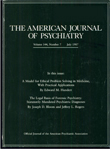Symptoms of obsessive-compulsive disorder
Abstract
OBJECTIVE: Obsessive-compulsive disorder encompasses a broad range of symptoms that represent multiple psychological domains, including perception, cognition, emotion, social relatedness, and diverse motor behaviors. The purpose of these analyses was to evaluate the correlational relationships of the symptoms of obsessive-compulsive disorder. METHOD: This study examined the 13 a priori categories used to group types of obsessions and compulsions in the Yale-Brown Obsessive Compulsive Scale symptom checklist in two independent groups of patients with obsessive-compulsive disorder (N = 208 and N = 98). A principal-components factor analysis with varimax rotation was performed, followed by a series of other exploratory analyses. RESULTS: The two data sets yielded nearly identical results. Four factors-- obsessions and checking, symmetry and ordering, cleanliness and washing, and boarding--emerged in each data set, in total accounting for more than 60% of the variance. CONCLUSIONS: Obsessive-compulsive disorder is a multidimensional and etiologically heterogeneous condition. The four symptom dimensions identified in this study are largely congruent with those identified in earlier reports. These factors may be of value in future genetic, neurobiological, and treatment response studies.



